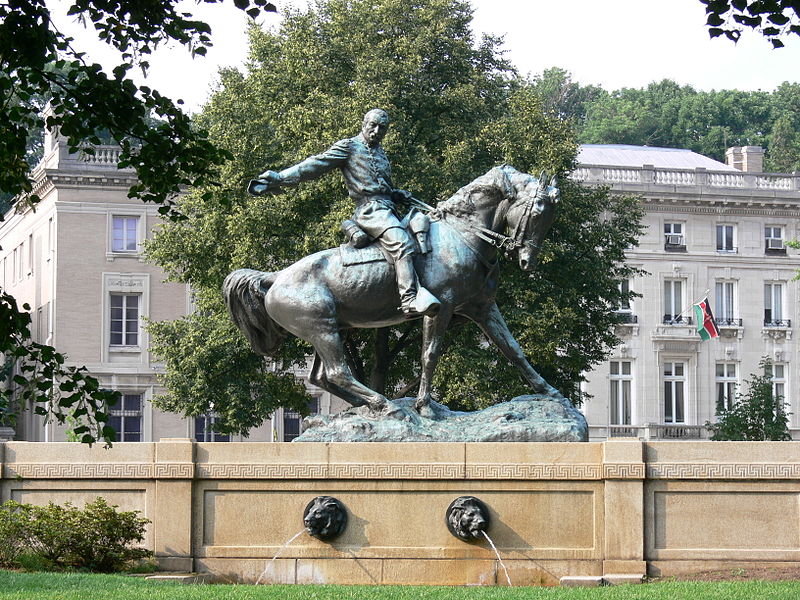Monday, May 29, 2017
A Decoration Day Memorial
This monument is found on the grounds of the Minnesota Veterans Home in Minneapolis, just a short distance from picturesque Minnehaha Falls. It honors the youthful Union soldiers that served in the War Between the States. A total of 2,334,568 boys age 18 and under, 25 of them as young as ten, fought for the Grand Army of the Republic between the shelling of Fort Sumter and Lee's surrender.
Sunday, May 21, 2017
An Observation by Adam Ferguson, 1767
Scottish Enlightenment philosopher Adam Ferguson makes this point in his An Essay on the History of Civil Society:
... the inhabitants of Britain, at the time of the first Roman invasions, resembled, in many things, the present natives of North America: They were ignorant of agriculture; they painted their bodies; and used for clothing the skins of beasts. Such, therefore, appears to have been the commencement of history with all nations, and in such circumstances are we to look for the original character of mankind. The inquiry refers to a distant period, and every conclusion should build on the facts which are preserved for our use. Our method, notwithstanding, too frequently, is to rest the whole on conjecture; to impute every advantage of our nature to those arts which we ourselves possess; and to imagine, that a mere negation of all our virtues is a sufficient description of man in his original state. We are ourselves the supposed standards of politeness and civilization; and where our own features do not [126] appear, we apprehend, that there is nothing which deserves to be known. But it is probable that here, as in many other cases, we are ill qualified, from our supposed knowledge of causes, to prognosticate effects, or to determine what must have been the properties and operations, even of our own nature, in the absence of those circumstances in which we have seen it engaged. Who would, from mere conjecture, suppose, that the naked savage would be a coxcomb and a gamester? that he would be proud or vain, without the distinctions of title and fortune? and that his principal care would be to adorn his person, and to find an amusement? Even if it could be supposed that he would thus share in our vices, and, in the midst of his forest, vie with the follies which are practised in the town; yet no one would be so bold as to affirm, that he would likewise, in any instance, excel us in talents and virtues; that he would have a penetration, a force of imagination and elocution, an ardour of mind, an affection and courage, which the arts, the discipline, and the policy of few nations would be able to improve. Yet these particulars are a part in the description which is delivered by those who have had opportunities of seeing mankind in their rudest condition: and beyond the reach of such testimony, we can neither safely take, nor pretend to give, information on the subject.

... the inhabitants of Britain, at the time of the first Roman invasions, resembled, in many things, the present natives of North America: They were ignorant of agriculture; they painted their bodies; and used for clothing the skins of beasts. Such, therefore, appears to have been the commencement of history with all nations, and in such circumstances are we to look for the original character of mankind. The inquiry refers to a distant period, and every conclusion should build on the facts which are preserved for our use. Our method, notwithstanding, too frequently, is to rest the whole on conjecture; to impute every advantage of our nature to those arts which we ourselves possess; and to imagine, that a mere negation of all our virtues is a sufficient description of man in his original state. We are ourselves the supposed standards of politeness and civilization; and where our own features do not [126] appear, we apprehend, that there is nothing which deserves to be known. But it is probable that here, as in many other cases, we are ill qualified, from our supposed knowledge of causes, to prognosticate effects, or to determine what must have been the properties and operations, even of our own nature, in the absence of those circumstances in which we have seen it engaged. Who would, from mere conjecture, suppose, that the naked savage would be a coxcomb and a gamester? that he would be proud or vain, without the distinctions of title and fortune? and that his principal care would be to adorn his person, and to find an amusement? Even if it could be supposed that he would thus share in our vices, and, in the midst of his forest, vie with the follies which are practised in the town; yet no one would be so bold as to affirm, that he would likewise, in any instance, excel us in talents and virtues; that he would have a penetration, a force of imagination and elocution, an ardour of mind, an affection and courage, which the arts, the discipline, and the policy of few nations would be able to improve. Yet these particulars are a part in the description which is delivered by those who have had opportunities of seeing mankind in their rudest condition: and beyond the reach of such testimony, we can neither safely take, nor pretend to give, information on the subject.

Thursday, May 18, 2017
Carl Menger Points Out the Truth
“There is no necessary and direct connection between the value of a good
and whether, or in what quantities, labor and other goods of higher
order were applied to its production. A non-economic good (a quantity of
timber in a virgin forest, for example) does not attain value for men
since large quantities of labor or other economic goods were not applied
to its production. Whether a diamond was found accidentally or was
obtained from a diamond pit with the employment of a thousand days of
labor is completely irrelevant for its value. In general, no one in
practical life asks for the history of the origin of a good in
estimating its value, but considers solely the services that the good
will render him and which he would have to forgo if he did not have it
at his command…The quantities of labor or of other means of production
applied to its production cannot, therefore, be the determining factor
in the value of a good. Comparison of the value of a good with the value
of the means of production employed in its production does, of course,
show whether and to what extent its production, an act of past human
activity, was appropriate or economic. But the quantities of goods
employed in the production of a good have neither a necessary nor a
directly determining influence on its value.”


Saturday, May 13, 2017
Friday, May 12, 2017
Gen. Phil Sheridan Memorial in Sheridan Circle

In February of 1868, Sheridan assumed command of the Department of Missouri and became responsible for enforcing the peace among the hostile Plains Indian tribes. He implemented the "Total War" strategy in the winter campaign of 1868-1869 against the Southern Cheyenne, Arapaho, Kiowa, and Comanche. Sheridan recalled Custer early from his suspension to lead the campaign, which was successful in driving the Southern Plains tribes onto reservations. Sheridan's standing orders to Custer were, "To kill all the warriors, capture all the women and children, destroy all camps and material goods, and kill all the ponies."
In 1869, when General William Tecumseh Sherman was made General-in-Chief of the U.S. Army, Sheridan was promoted to lieutenant general and assumed command of the Military District of Missouri, which extended from the Mississippi River west to the Rocky Mountains north and south from Canada to Mexico borders. He was involved in the Red River Wars of 1874-75, the Great Sioux Wars of 1876-77, and the Nez Perce War of 1877.
Tuesday, May 9, 2017
Gypsum Board As Art

Sunday, May 7, 2017
Lawn Care As A Religion
The English-speaking world, having dismissed traditional monotheistic religion as mythology, needs other things on which to base their values. There's faux democracy, of course, but that's seldom important on a personal level except for the most deranged. For the normal American, Canadian and even many Brits, especially those that reside in the suburbs, the lawn around their home has become a focal point that has taken the place of religion in day to day life.
Lawns as we know them probably originated with English tourists returning home from visits to France in the seventeenth century. Always aware of their cultural inferiority to the French, as they are today, the English saw the large and opulent grounds of the French aristocracy as a goal for themselves. Only a generation or two from living under the same roof with their livestock, the primitive English kicked their pigs out of their bedrooms, enclosed the commons and put their tenants to task manicuring their estates.
The Puritans brought this phenomenon to the New World and even today no American detached home is considered livable without a surrounding patch of carefully manicured and watered grass. Business facilities also include elaborate landscaping, not all of which is devoted to parking for employees and customers.
A major aspect of this conformity is regulation. Virtually all municipalities require that "weeds", ie. plants that aren't of the fescue or bluegrass type, be kept down or eliminated. Dandelions and creeping charlie are frowned upon, thistles and burdocks abhorred. These regulations are based upon the theory that the unmanicured yard of a neighbor reflects poorly on the property values and even character of others. It costs me money if you don't mow your lawn. Mammon being the true deity of the West, a decrepit lawn becomes a sin.
Oddly, it's not generally accepted to discourage the seating of an unattractive person at an adjacent table in a restaurant because their presence might make one look bad. In fact, even ugly people are allowed in toney restaurants as long as they're fairly clean and wearing clothes and have credit cards.
The true raison d'etre of the modern lawn is signalling. Since the lawn itself is no longer used for the grazing of livestock and only occasionally for recreational purposes, the odd croquet game on July 4th, it's real purpose is ostentation. A useless and unnecessary expense is the ultimate signal of wealth. More acreage implies more wealth. The best signal is a large grounds maintained by a well-paid landscaping company. No one of high status personally mows their own lawn.
Middle class suburbanites cherish their lawns as an indication that they've moved up from the concrete and asphalt surroundings of the inner city, even though the city dwellers probably spend more time outside. The typical man on the cul de sac fights traffic on his way to work in the city, spends the day there, fights even worse traffic home, kicks back before the one-eyed monster, eats, slugs back a few beers and then retires so he can do it again the next day. A couple of times a week he might pull the Lawn Boy out of the garage to clip the Bermuda grass but that's the extent of his commune with nature, such as it is.
Lawns as we know them probably originated with English tourists returning home from visits to France in the seventeenth century. Always aware of their cultural inferiority to the French, as they are today, the English saw the large and opulent grounds of the French aristocracy as a goal for themselves. Only a generation or two from living under the same roof with their livestock, the primitive English kicked their pigs out of their bedrooms, enclosed the commons and put their tenants to task manicuring their estates.
The Puritans brought this phenomenon to the New World and even today no American detached home is considered livable without a surrounding patch of carefully manicured and watered grass. Business facilities also include elaborate landscaping, not all of which is devoted to parking for employees and customers.
A major aspect of this conformity is regulation. Virtually all municipalities require that "weeds", ie. plants that aren't of the fescue or bluegrass type, be kept down or eliminated. Dandelions and creeping charlie are frowned upon, thistles and burdocks abhorred. These regulations are based upon the theory that the unmanicured yard of a neighbor reflects poorly on the property values and even character of others. It costs me money if you don't mow your lawn. Mammon being the true deity of the West, a decrepit lawn becomes a sin.
Oddly, it's not generally accepted to discourage the seating of an unattractive person at an adjacent table in a restaurant because their presence might make one look bad. In fact, even ugly people are allowed in toney restaurants as long as they're fairly clean and wearing clothes and have credit cards.
The true raison d'etre of the modern lawn is signalling. Since the lawn itself is no longer used for the grazing of livestock and only occasionally for recreational purposes, the odd croquet game on July 4th, it's real purpose is ostentation. A useless and unnecessary expense is the ultimate signal of wealth. More acreage implies more wealth. The best signal is a large grounds maintained by a well-paid landscaping company. No one of high status personally mows their own lawn.
Middle class suburbanites cherish their lawns as an indication that they've moved up from the concrete and asphalt surroundings of the inner city, even though the city dwellers probably spend more time outside. The typical man on the cul de sac fights traffic on his way to work in the city, spends the day there, fights even worse traffic home, kicks back before the one-eyed monster, eats, slugs back a few beers and then retires so he can do it again the next day. A couple of times a week he might pull the Lawn Boy out of the garage to clip the Bermuda grass but that's the extent of his commune with nature, such as it is.
Tuesday, May 2, 2017
Children's Day at the Mexican Border

Subscribe to:
Posts (Atom)


